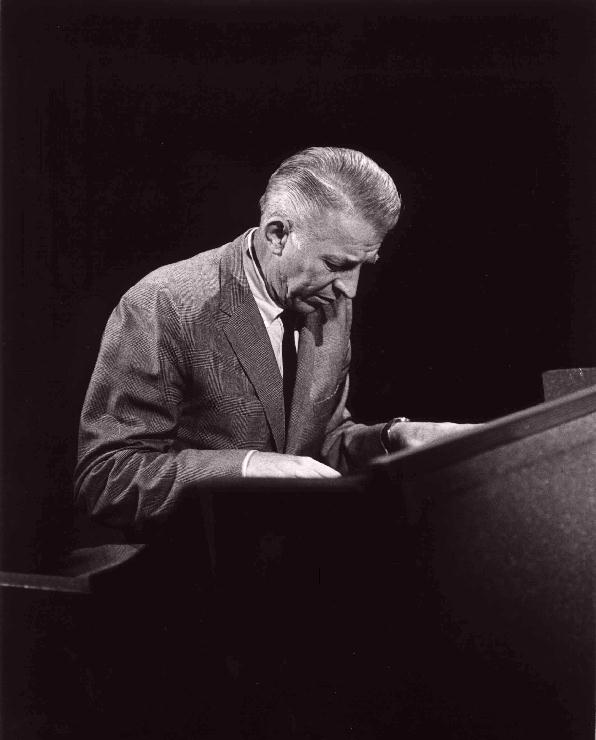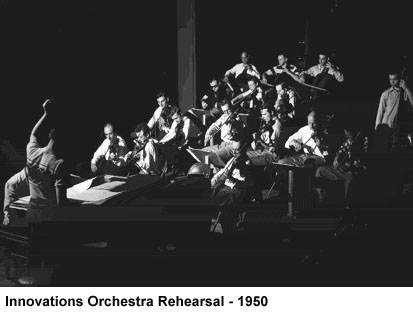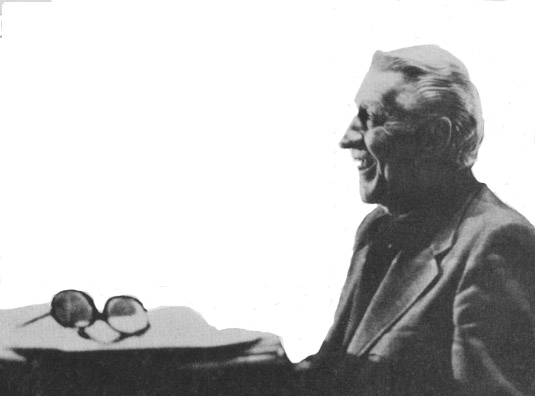Last Memorial Day, Stan Kenton
celebrated
the twentieth anniversary of the date when, at the Rendezvous Ballroom
in Balboa, California, he made his first appearance as a bandleader.
Since his 1941 debut Kenton
has built
and maintained a unique reputation, not simply as a leader, pianist or
composer/arranger, but as a dynamic personality and possibly the most
controversial
figure in jazz history. His turbulent and catalytic career has been
followed
by fans whose intensity and devotion is extraordinary. In 1958, when
the
band was playing its first European tour but was unable to work in
England,
the London 'Melody Maker' arranged for the chartering of a dozen
planes,
as well as a special Kenton boat excursion across the Irish Sea, that
took
jazz starved enthusiasts to Dublin.
 The strong emotions that
Kenton inspires
in those who admire his music as well as in those who reject it can be
attributed in large part to the forceful character of the man himself.
Though he spent several years jobbing around the West Coast as a
sideman
with various bands, it was inevitable that he would establish himself
as
a leader.
The strong emotions that
Kenton inspires
in those who admire his music as well as in those who reject it can be
attributed in large part to the forceful character of the man himself.
Though he spent several years jobbing around the West Coast as a
sideman
with various bands, it was inevitable that he would establish himself
as
a leader.
Kenton's first band, a
relatively small
one by his later standards (five saxophones, three trumpets, two
trombones
and four rhythm) was a more direct reflection of its leader than the
subsequent
groups, since he himself was responsible for a large proportion of the
arrangements. Their dominant characteristic was a choppy, staccato
manner
of phrasing that was especially noticeable in the writing for the reed
section. In retrospect this emerges as one of the most readily
identifiable
of all the Kenton ensembles.
A study of that early group,
and of
all the later ventures provides a complex, many-sided answer to the
question:
What does the Kenton name mean in the annals of modern music?
Specifically, for those who
have examined
his work cursorily or read about it in the lay press, Kenton is
primarily
a symbol of ambitious, big band jazz, a man on whom the label of
'progressive
jazz' was still pinned many years after he had dropped the slogan. To
others
Kenton has been a pioneer in the incorporation of Latin and Afro-Cuban
rhythms into jazz contexts. Not long after the dissolution of his
original
band in the Spring of 1946, Kenton began recording with a group
that
included maracas, bongo and conga drums, and the unique finger-style
Spanish
guitar of Brazilian-born Laurindo Almeida. Kenton's intermittent
romance
with South America has produced some of his most colorful and durable
music,
notably the CD 'Cuban Fire,' written by Johnny Richards in 1956.
Still other Kenton followers
identify
him principally with the attempt to incorporate into his library a body
of 'classical' concert music, composed and brilliantly orchestrated by
writers well qualified to blend the European classical and American
jazz
elements. This sort of fusion has become a relatively common phenomenon
in the past two or three years. Paradoxically the experts who have
spent
much of their time dissecting the recent efforts along these lines, by
such talented writers as John Lewis and Gunther Schuller, rarely
acknowledge
that more than a decade ago Kenton was engaged in just such a series of
amalgamations, recording classical and semi-classical compositions by
Franklyn
Marks, Pete Rugolo, the late Bob Graettinger and others. These works,
performed
by a forty-piece orchestra with a large string section, were heard in a
concert tour undertaken by Kenton in 1950 under the banner 'Innovations
in Modern Music.' The orchestra and its tour marked a vital phase in
the
Kenton career.
 Though nothing he has done
since that
period is the equal of the 'Innovations' in terms of instrumentation or
of experimentation, there have been several ventures during the past
ten
years that are, in the opinion of many observers, closer to the core of
jazz, and represent Kenton's most swinging efforts. It is with the
1953-1958
period, when his band was concerned more with the beat than breaking
new
ground, that many of his younger followers associate him most closely.
Though nothing he has done
since that
period is the equal of the 'Innovations' in terms of instrumentation or
of experimentation, there have been several ventures during the past
ten
years that are, in the opinion of many observers, closer to the core of
jazz, and represent Kenton's most swinging efforts. It is with the
1953-1958
period, when his band was concerned more with the beat than breaking
new
ground, that many of his younger followers associate him most closely.
In addition to the four
phases outlined
above (the original band, the Latin period, the Innovations and the
modern
swinging band) there were, simultaneously with some of the later
undertakings,
a series of commercially geared recordings with which Kenton was heard
with a vocal group; playing lush arrangements with a string ensemble;
and
trying out novelty numbers for the single record market. Obviously,
then,
for anyone who has followed his career observantly through all these
stages,
these greatly varied divagations, it is illogical to state that there
is
any such firm entity as 'the Stan Kenton style.' The Kenton musical
identity
has changed according to the particular objective he was seeking at any
given juncture and most important, the style of the arranger working
for
him.
Recently, after a brief
period of inactivity,
Kenton embarked on a fifth major phase. Discounting all the danger
signals,
unwilling to write off big band jazz as a spent force, he organized a
new
orchestra with no less than fourteen men in the brass section alone.
This
brass team included four exponents of a new instrument designed to his
specifications and known as the mellophonium. Its range is a fifth
below
that of the trumpet and Kenton feels it fills the gap between trumpets
and trombones. With the addition of five saxophones, and a rhythm
section
that includes a second percussionist, Kenton now has a twenty-two piece
orchestra. His courage in embarking on an undertaking of his kind, at a
period when big bands are encountering so many problems, has been
applauded
by his colleagues in the profession. It is perhaps symbolic of his
stubborn
refusal to concede defeat that his twentieth anniversary as a leader
was
spent, not at home celebrating, but at Crystal Beach, Ontario, playing
a one-night stand.
An extraordinary aspect of
the Kenton
story is the continuous stream of talents for which the band has served
as a proving ground. In this space it is possible only to give a random
sampling. Among the most distinguished Kenton alumni and alumnae are
such
arrangers as Pete Rugolo, Gene Roland, Johnny Richards, Shorty Rogers
and
Bill Holman; singers Anita O'Day, June Christy and Chris Connor;
trumpeters
Maynard Ferguson, Ernie Royal, Conte Candoli; trombonists Milt
Bernhart,
Frank Rosolino, Jimmy Knepper, Bob Fitzpatrick; alto saxophonists Bud
Shank,
Charlie Mariano, Lee Konitz, Boots Mussulli, Art Pepper; tenor
saxophonists
Bob Cooper, Stan Getz, Zoot Sims, Vido Musso; bassists Eddie Safranski,
Don Bagley; drummers Shelly Manne and Stan Levey.
 No less remarkable has been
Kenton's
ability to achieve his objectives with little or no help, from the
critics.
Most of the leading so-called experts, including this writer, have
taken
issue with him at one time or another on musical or other matters; yet
the jazz public has systematically ignored the critics and supported
him
loyally. Certainly the best measure of Kenton's contribution can be
found
in the comments of those who have worked for him and have thus seen at
first hand his strength and determination of purpose.
No less remarkable has been
Kenton's
ability to achieve his objectives with little or no help, from the
critics.
Most of the leading so-called experts, including this writer, have
taken
issue with him at one time or another on musical or other matters; yet
the jazz public has systematically ignored the critics and supported
him
loyally. Certainly the best measure of Kenton's contribution can be
found
in the comments of those who have worked for him and have thus seen at
first hand his strength and determination of purpose.
'Stan's most important
contribution,'
says Johnny Richards, 'is his constant devotion to music and support of
young talent. And the most amazing thing about him personally is his
tirelessness.
I tried to keep up with him once on the road and I had to quit -- it
made
a wreck out of me. He can travel eight hundred miles by bus in two
days,
and then, instead of resting in a hotel room, he'll push right out to
appear
on three radio shows before the job starts. His energy is endless."
'Stan has had several
different kinds
of fine bands,' recalls Shelly Manne. "The Innovations' one was great,
but not as significant to me as a 1948 concert band I played in for
which
Rugolo and Graettinger were writing. And his best jazz band ever,
several
years after I left, was the 'Contemporary Concepts' one in 1955."
Several former Kenton
sidemen agree
with Manne that this was the best band. Others, including Stan Levey,
vote
for the 1953 orchestra that toured Europe, with Conte Candoli, Frank
Rosolino,
Bob Fitzpatrick,
Lee Konitz, Zoot Sims and Stan Levey in the cast.
Perhaps the most eloquent
summation
of his alumni's feelings toward him were expressed by Bill Holman, the
composer/arranger who, like so many during the the past two decades,
has
progressed from the Kenton band to individual recognition and the
direction
of his own recording groups.
"Stan Kenton has improved
the image
of jazz and its musicians," said Holman. "He was one of the first big
band
leaders to utilize the concert approach; he was able, through a
dramatic
musical presentation and, through his forceful personality and
eagerness
to discuss jazz, to reach many new listeners and remove some of the
stigma
from the word itself."
With the big-jazz-band scene
reduced
to a point at which he has only two permanently active contemporaries,
Ellington and Basie, one can only add the hope that Stan Kenton and his
orchestra will continue the pattern of experiment, contention and
catalysis
that have marked their past twenty tumultuous years.